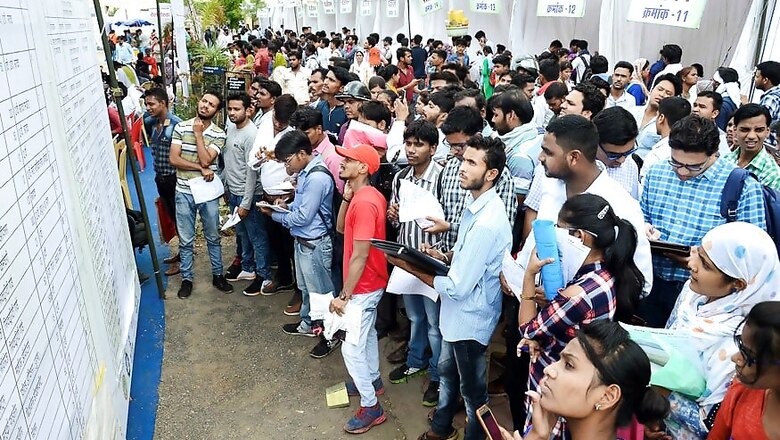
views
New Delhi: The two biggest challenges for Modi 2.0 are a slowing economy and a severe unemployment crisis. Both the pain points are a legacy of this government’s first term, a five-year period when at least on the jobs front, the government remained in complete denial.
In a famous television interview in January 2018, Prime Minister Narendra Modi had waived aside all criticism on lack of jobs and said selling ‘pakoras’ also counted as employment. This ‘pakodanomics’ was mocked by the Opposition and subsequently led to a fierce debate over the number of jobs being created, the quality of these jobs and whether there were enough jobs for the millions of Indians who were joining the labour force afresh every year.
In that TV interview, the PM had said, “In one year, more than 70 lakh provident fund accounts have been added. Over 10 crore people have benefited from Mudra Yojana launched by the Centre... Government initiatives have empowered small-scale entrepreneurs and informal sectors. If someone opens a 'pakoda' shop in front of your office, does that not count as employment? The person's daily earning of Rs 200 will never come into any books or accounts. The truth is massive people are being employed.”
Now, as the latest economic and jobs data underlines the massive problems at hand, there is reluctant acknowledgment that things do not look too bright. The government’s own data show that GDP growth was the slowest in five years last fiscal, falling below the 7% mark (at 6.8%) in 2018-19. In the last quarter of that year, GDP growth was only 5.8%, lowest in 20 quarters. As for unemployment, the government’s Periodic Labour Force Survey — which was finally released earlier this month — showed unemployment reached a 45-year high at 6.1% in 2017-18, with the youth, the educated and women facing the most trouble in getting jobs.
And this is not all. Unemployment has continued to rise in 2019 too and according to estimates by the Centre for Monitoring the Indian Economy (CMIE), the unemployment rate in May this year was 7.17%. This was slightly better than the 7.35% in April but much higher than the 6% average in 2018.
The CMIE unemployment database comprises about 522,000 people, providing employment or unemployment status for each member (who is greater than or equal to 15 years of age). For the government’s first annual PLFS, 12,800 First Stage Units or FSUs (7,024 villages and 5,776 UFS blocks) were surveyed at the all-India level during July 2017-June 2018. The PLFS covered 102,113 households (56,108 in rural areas) and 433,339 persons.
So as the economic engine slows down and more jobs continue to vanish, it is heartening to see that the government has finally woken up. Earlier this week, the Prime Minister formed two Cabinet committees to address economic woes and unemployment. Of these, the Cabinet Committee on Employment and Skill Development (CCESD) is tasked with tackling the jobs challenge. Besides Modi, it comprises 14 top ministers, including those heading finance, agriculture, commerce, small & medium enterprises, labour and HRD ministries.
So how bad is the jobs scenario in India? The PLFS highlights some alarming trends:
One, as unemployment breached a four-decade-high figure, it is the urban youth who face the worst prospects for a job. The PLFS says 18.7% or every sixth urban male youth, aged between 15-29 years, was unemployed in 2017-18. The only group which fared worse than even the young urban male was the young urban female, since more than one in four were unemployed at 27.2%.
Two, during 2017-18, about 54.9% of rural males and 18.2% of rural females were in the labour force; about 57% urban males and 15.9% urban females were in the labour force. This means, just about one in two rural men and a little more than one in two urban men were working at a job; about one in six rural women and less than one in six urban women held a job.
Three, between 2004-05 and 2011-12 as well as between 2011-12 and 2017-18, the labour force participation rate for rural males remained almost at the same level. Between 2004-05 and 2011-12, for rural female, LFPR decreased by nearly 8 percentage point and between 2011-12 and 2017-18 it further decreased by around 7 percentage points. Between 2004-05 and 2011-12 as well as between 2011-12 and 2017-18 rounds, LFPR for urban males remained at the same level. For urban females, between 2004-05 and 2011-12, LFPR decreased by about 2 percentage points and between 2011-12 and 2017-18, it remained almost at the same level. So more and more rural women are dropping out of the workforce.
Four, the unemployment rate for educated Indians was significantly higher compared to the overall rate. For educated (highest level of education secondary and above) rural males and rural females, unemployment rates were 10.5% and 17.3% respectively.
As per CMIE data too, there is an upward trend in the unemployment series; the unemployment rate is rising because employment has stagnated and there is a steady and large stream of new employment seekers entering the labour market.
“This is particularly true for urban India, where employment is falling. Employment in urban India during each of the ten months ending May 2019 was lower than it was during the corresponding month a year ago. In 11 of the past 12 months, employment in urban India was lower than it was a year ago. While urban employment has been falling, the ranks of the urban unemployed have been rising steadily,” CMIE said.
It is evident that a severe jobs crisis is on our hands. The sooner the government addresses it through a mix of policy initiatives and measures to boost the economy (which will in turn create jobs), the better it will be.
(Author is a senior journalist. Views are personal)



















Comments
0 comment